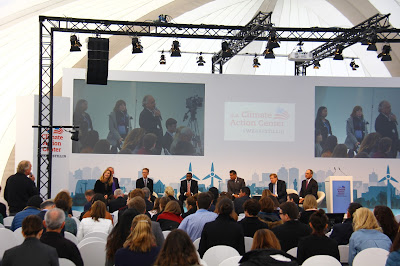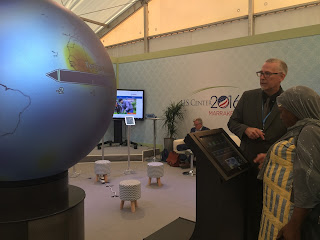Wait, didn’t the US leave the Paris Agreement?
Posted by: Dr. Aaron Strong
Wait, didn’t the US leave the Paris Agreement?
You may well remember the big lead up to the announcement the week after Memorial Day this year: Would President Trump really decide to quit the Paris Agreement – the most recent and first truly global climate treaty that involves commitments for climate action from the whole world? And then it happened: President Trump, following advice from Scott Pruitt, announced that the USA would leave the Paris “Accord” (it’s not actually the Paris Accord, it’s the Paris Agreement, but he didn’t/doesn’t know that). Of course, even from Trump’s perspective, actually leaving was really unnecessary because the Agreement is built on self-defined pledges and Scott Pruitt’s EPA had already initiated the gutting of the cornerstone of the US pledge (the Clean Power Plan), so quitting really just means that the US wouldn’t be a party coming together to discuss and coordinate those pledges. We were quitting an agreement to get together to talk, nothing more. So, then, why is the US delegation still at these climate talks – talks designed to implement the Paris Agreement – taking place now in Bonn?
The simple answer is that under the Paris Agreement’s rules it takes four years to leave the agreement (I’m really glad no one told President Trump he could leave the broader overarching 1992 UN Framework Agreement on Climate Change in just one year, rather than the four year period required to quit Paris). So the US is still “in” and still a “Party”, at least for the time being.
The complex answer is that much of the US negotiation team are career staff, have been to previous negotiations under previous administrations, and have (or so it seems from my observations) not exactly received detailed instructions to totally change course from the new administration. So far, the US has been largely quiet in the negotiations I have observed, but also present as an active and engaged participant. They have, at times, offered constructive input that helps advance consensus in the minutiae of the Agreement. Certainly, the US does have a reduced delegation size and lacks a formal government-run pavilion that most other major countries have, but they are definitely still here and still participating in negotiations, though to what end isn’t totally clear. (UMaine Delegation Member Anna McGinn’s post about what to expect from the US has excellent information on the lead up to COP 23. http://umainecop23.blogspot.com/2017/11/the-us-at-cop23.html)
But, what is really clearly visible is the presence of US politicians representing cities and states, as well a US businesses and NGOs, who have all come together as part of the We Are Still In coalition to represent America’s societal and subnational-level commitment to the Agreement. Most visibly, We Are Still In has a large “US Climate Action Pavillion”. It’s not an official government installation, but it is, dramatically, smack next to the main negotiations (unlike all the other Pavilions that are about a kilometer away). When you exit the building where the negotiation is happening you are confronted with a huge US Climate Action sign.
And part of the point is this: If the states and cities that have committed to implementing the Paris Agreement were their own country, they’d be one of the largest economies in the world and a major player in the negotiations. And they are. Governor Brown of California and Governor Inslee of Washington State are rockstar politicians, thronged by media and assistants as they move from event to event highlighting the need for climate action here at Paris. They may not be formal negotiators, but these politicians and US-led NGOs are major leaders in all facets of the negotiations. So, while the official State Department team may be reduced in numbers and lacking clear guidance, the message that a large part of America is committed to global climate policy is being heard loud and clear.
Wait, didn’t the US leave the Paris Agreement?
You may well remember the big lead up to the announcement the week after Memorial Day this year: Would President Trump really decide to quit the Paris Agreement – the most recent and first truly global climate treaty that involves commitments for climate action from the whole world? And then it happened: President Trump, following advice from Scott Pruitt, announced that the USA would leave the Paris “Accord” (it’s not actually the Paris Accord, it’s the Paris Agreement, but he didn’t/doesn’t know that). Of course, even from Trump’s perspective, actually leaving was really unnecessary because the Agreement is built on self-defined pledges and Scott Pruitt’s EPA had already initiated the gutting of the cornerstone of the US pledge (the Clean Power Plan), so quitting really just means that the US wouldn’t be a party coming together to discuss and coordinate those pledges. We were quitting an agreement to get together to talk, nothing more. So, then, why is the US delegation still at these climate talks – talks designed to implement the Paris Agreement – taking place now in Bonn?
The simple answer is that under the Paris Agreement’s rules it takes four years to leave the agreement (I’m really glad no one told President Trump he could leave the broader overarching 1992 UN Framework Agreement on Climate Change in just one year, rather than the four year period required to quit Paris). So the US is still “in” and still a “Party”, at least for the time being.
The complex answer is that much of the US negotiation team are career staff, have been to previous negotiations under previous administrations, and have (or so it seems from my observations) not exactly received detailed instructions to totally change course from the new administration. So far, the US has been largely quiet in the negotiations I have observed, but also present as an active and engaged participant. They have, at times, offered constructive input that helps advance consensus in the minutiae of the Agreement. Certainly, the US does have a reduced delegation size and lacks a formal government-run pavilion that most other major countries have, but they are definitely still here and still participating in negotiations, though to what end isn’t totally clear. (UMaine Delegation Member Anna McGinn’s post about what to expect from the US has excellent information on the lead up to COP 23. http://umainecop23.blogspot.com/2017/11/the-us-at-cop23.html)
But, what is really clearly visible is the presence of US politicians representing cities and states, as well a US businesses and NGOs, who have all come together as part of the We Are Still In coalition to represent America’s societal and subnational-level commitment to the Agreement. Most visibly, We Are Still In has a large “US Climate Action Pavillion”. It’s not an official government installation, but it is, dramatically, smack next to the main negotiations (unlike all the other Pavilions that are about a kilometer away). When you exit the building where the negotiation is happening you are confronted with a huge US Climate Action sign.
And part of the point is this: If the states and cities that have committed to implementing the Paris Agreement were their own country, they’d be one of the largest economies in the world and a major player in the negotiations. And they are. Governor Brown of California and Governor Inslee of Washington State are rockstar politicians, thronged by media and assistants as they move from event to event highlighting the need for climate action here at Paris. They may not be formal negotiators, but these politicians and US-led NGOs are major leaders in all facets of the negotiations. So, while the official State Department team may be reduced in numbers and lacking clear guidance, the message that a large part of America is committed to global climate policy is being heard loud and clear.





Comments
Post a Comment